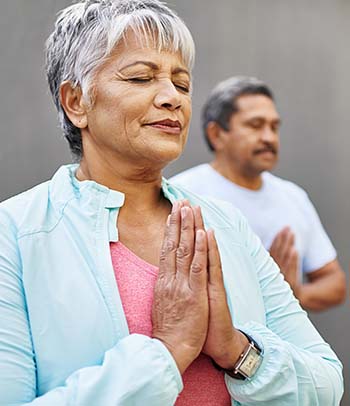As we kick off a new year, many of us start thinking about ways to improve our health. Our goals might include eating more plants or finding more time to exercise, but it’s just as important to focus on ways we can improve our mental health. Meditation and mindfulness are getting a lot of attention lately as techniques we can use to reduce stress, feel more relaxed, increase attention span, and even cope with symptoms of post-traumatic stress disorder (PTSD), insomnia, anxiety and more.
Check out the information below to learn more about meditation and mindfulness, its benefits and some tips for getting started.
What Is Meditation or Mindfulness?
People use meditation and mindfulness exercises for a variety of reasons, including to decrease stress levels, deal with challenging situations, and help with health conditions such as chronic pain, anxiety and more.
Meditation has been practiced for thousands of years and often refers to a variety of techniques or practices focusing on mind and body integration with the intent of calming your mind. Some types of meditation involve a particular focus on breathing, or a mantra or a sound.
Mindfulness is a type of meditation based on the idea of being mindful or aware of the present without making judgments of self or others. It may include meditation practices such as focusing on your breath or different sensations in your body.
Both meditation and mindfulness begin with a desire to calm the mind and reduce the stress inside of us.
Why Should I Try It?

People use meditation and mindfulness exercises for a variety of reasons, including to decrease stress levels, deal with challenging situations, and help with health conditions such as chronic pain, anxiety and more. Whatever the reason, there are some common benefits people cite.
- Anyone can try it.
- It doesn’t require any equipment.
- It doesn’t have to cost any money.
- You can practice it anywhere.
- It can give you a sense of calm and peace throughout the day as you become stressed, overworked, anxious or depressed.
- It can help you focus your attention and keep you feeling productive.
- It can provide you with techniques to stay focused on the present, instead of worrying about the future or dwelling on the past.
- Consistent meditation and mindfulness can provide physical health benefits as well, including lowering your resting blood pressure and heart rate, improving your sleep quality and reducing the symptoms of anxiety, depression and other health conditions.
How Do I Get Started?
There is no right way to start. Techniques vary from person to person, so part of your journey will be to discover what works best for you. However, there are some common elements that can help you get started.
- Find a quiet and calm setting. If you’re a beginner, it might be easier to focus if you can remove distractions such as TV or cell phones. As you get better at it, you may be able to do it during more intense situations, like in traffic or before a work presentation to calm yourself down.
- Relax your breathing. When we get stressed or anxious, it’s common to get worked up. If you make a point to take deep, even breaths, you can learn to control your breathing, slow it down and take in more oxygen.
- Focus your attention. This is often one of the most important aspects of meditation. You can use it to free your mind from things that cause stress and worry – and instead focus on something else, such as your breathing, a specific object or a mantra that you can repeat over and over.
- Seek help. You can try to meditate or practice mindfulness on your own, but you can also seek help when you’re getting started. You can take classes, use an app on your phone or ask someone you know that’s got some experience to guide you through a few sessions.
- Don’t be too hard on yourself. Meditation, like anything else you’re starting, takes practice. At first you may find you can’t stop your mind from drifting toward negative thoughts or your long to-do list. These issues are common, but consistently guiding yourself back to your meditation is what will help you learn to stay mindful.
- Find what works for you. There’s no right or wrong way to meditate, so adapt your meditation to meet your needs. You may find you do best if you combine your meditation with fresh air or a walk. You may find it works best to do it in the morning or right before bed.
- Set a time limit. If the thought of meditation overwhelms you, start with a set amount of time to help reduce the pressure of “success.” Many experts recommend trying one minute to start and working up from there. Even 5-10 minutes a day has been shown to provide health benefits.
What Techniques Can I Try Today?
 You can be as formal or informal as you want when you begin to practice meditation or mindfulness, and it may take some time to figure out what works best for you, but if you want to try some easy techniques today, here are some suggestions:
You can be as formal or informal as you want when you begin to practice meditation or mindfulness, and it may take some time to figure out what works best for you, but if you want to try some easy techniques today, here are some suggestions:
- Breathe deeply – Concentrate on feeling and listening to your breath as you inhale and exhale deeply and slowly. For example, you can try taking 10 deep breaths, inhaling for three seconds and exhaling for three seconds and repeating this ten times. When your mind starts to wander, recognize what’s happening and gently return your focus to your breathing. You may have to do this several times throughout the exercise. If you take these 10 deep breaths, you have done a minute of meditation to start your day.
- Focus on each part of your body – Take a moment to slowly “walk” through different parts of your body, starting at the top of your head. Work your way through each muscle group, tightening your muscles and relaxing them as you go, becoming aware of where you’re holding tension and where there’s pain, if any. Try to guide each muscle into a relaxed state. As you do this, try to take slow and even breaths.
- Take a walk outdoors – Combine a portion of your daily exercise with meditation. You can listen to a relaxation podcast as you walk, or you can try to quiet your thoughts and focus your attention on your breathing and your movement for a portion of time, slowing down your pace and concentrating on each step. As your mind wanders, acknowledge it and slowly bring your focus back to your movement.
- Repeat a mantra – For some people, a calming mantra or something you repeat over and over can help you relax and stay focused. A mantra can be a short prayer or just a word or phrase that has special meaning for you.
- Use a guided meditation – If taking a walk or finding a few minutes for yourself isn’t helping to calm your mind, try getting help. A quick search on the Internet will pull up tons of guided meditations you can use. You can find one-minute meditations, 10-minute exercises, apps that offer soothing music and much more.
Additional Resources
- The National Institutes of Health offers findings released from several studies about meditation and its effect on stress, anxiety, high blood pressure, PTSD and more.
- The Department of Veterans Affairs (VA) offers meditation and mindfulness-based interventions as one of the complementary and integrative health approaches within their Whole Health System of care. Interventions include mindfulness-based stress reduction, cognitive therapy, relapse prevention and more. VA also offers a Mindfulness Coach app that provides you with a self-guided training program to help you get started.
Even a few minutes a day devoted to practicing meditation can improve your mental health and well-being. Make it a part of your health and wellness journey this year.







